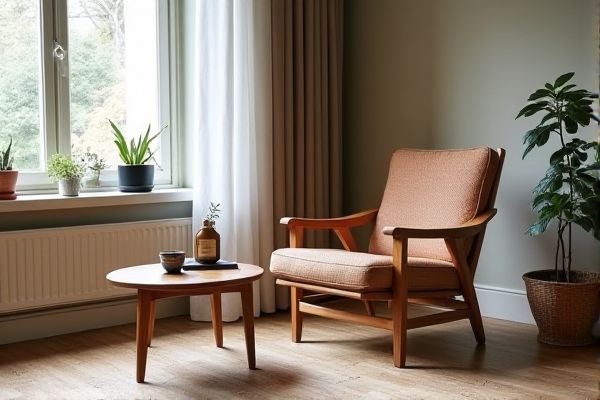
Bentwood chairs feature a smooth, curved design formed by steaming wood, offering a lightweight yet sturdy seating option, while crossback chairs boast a distinctive X-shaped backrest that adds rustic charm and robust support. Explore the full article to discover which chair style perfectly complements Your interior design and seating needs.
Table of Comparison
| Feature | Bentwood Chair | Crossback Chair |
|---|---|---|
| Design | Curved wood frame with rounded backrest | Distinctive X-shaped backrest for support |
| Material | Steam-bent wood, usually beech | Wood, often oak or pine |
| Weight | Lightweight and easy to move | Heavier, sturdier build |
| Comfort | Ergonomic curves, cushioned or bare | Firm back support, often padded seat |
| Style | Classic, vintage, elegant | Rustic, farmhouse, casual |
| Typical Use | Cafes, bistros, elegant dining | Rustic weddings, farmhouse dining |
| Durability | Flexible yet strong | Robust, solid construction |
| Price Range | Moderate to high | Affordable to moderate |
Introduction to Bentwood and Crossback Chairs
Bentwood chairs, originating from the 19th century, are crafted by steaming wood to bend it into elegant, curved shapes, making them lightweight and durable with a smooth, polished finish. Crossback chairs, popular in rustic and farmhouse decor, feature a distinctive "X" design on the backrest, offering sturdy support and a timeless aesthetic. Both chair styles blend craftsmanship and functionality, ideal for various interior design settings.
Historical Background of Bentwood Chairs
Bentwood chairs trace their origins to the 19th century, pioneered by Michael Thonet, whose innovative steam-bending technique revolutionized furniture design by creating lightweight, durable, and elegantly curved wooden chairs. These chairs became iconic in European cafes and homes, symbolizing craftsmanship and industrial ingenuity. Your appreciation for classic furniture gains depth when understanding the rich historical background and influence of bentwood chairs on modern design.
Origins and Evolution of Crossback Chairs
Crossback chairs originated in 19th-century France, designed as sturdy, lightweight seating for rural cafes and bistros, characterized by their distinctive X-shaped back braces. Their evolution reflects a blend of rustic charm with functional craftsmanship, making them popular worldwide for both indoor and outdoor use. Unlike bentwood chairs, which use steam-bent wood techniques from the mid-19th century Austria, crossback chairs emphasize hand-joined wooden elements for a more artisanal aesthetic.
Materials and Construction Techniques
Bentwood chairs utilize steamed wood bent into smooth, curved shapes, typically made from beech or oak, ensuring lightweight yet durable construction through steam-bending methods. Crossback chairs feature solid wood frames with x-shaped back supports, often crafted from hardwoods like pine or eucalyptus, assembled using traditional joinery techniques for enhanced stability. Both chair types prioritize craftsmanship, but bentwood emphasizes fluid curves formed by bending processes, while crossback relies on angular, reinforced joints for structural integrity.
Design Features: Curves vs. Crossbacks
Bentwood chairs feature elegant, continuous curves formed by steaming and bending wood, creating a smooth, flowing silhouette that emphasizes simplicity and craftsmanship. Crossback chairs showcase a distinctive X-shaped backrest, providing structural support and a rustic, geometric aesthetic that contrasts with the organic curves of bentwood designs. Both styles blend functionality and visual appeal, with bentwood focusing on fluid lines and crossback highlighting bold, angular patterns.
Comfort and Ergonomics Comparison
Bentwood chairs offer superior ergonomic support with their curved backrests designed to follow the natural contour of the spine, promoting better posture and enhanced comfort during extended seating. Crossback chairs feature a sturdy X-shaped backrest that provides moderate lumbar support but may not conform as closely to the body's shape, potentially resulting in less overall ergonomic benefit. For long-term comfort, bentwood chairs are often preferred due to their smooth, flexible wood construction that adapts subtly to the sitter's position.
Durability and Maintenance Requirements
Bentwood chairs offer exceptional durability due to their steam-bent solid wood construction, which provides flexibility and resistance to cracks and breaks. Crossback chairs, typically crafted from hardwood like oak or beech, also ensure strong structural integrity but may require regular tightening of bolts or screws to maintain stability. Both chair styles benefit from periodic cleaning with mild soap and water, though bentwood finishes often demand less maintenance to preserve their smooth, curved surfaces compared to the more textured frames of crossback chairs.
Suitability for Different Interior Styles
Bentwood chairs offer a timeless elegance with their smooth curves and refined craftsmanship, making them ideal for classic, vintage, and Scandinavian interior styles. Crossback chairs feature a rustic and farmhouse charm with their distinctive X-shaped backrest, perfectly complementing country, industrial, and shabby chic decors. Both styles provide versatile seating options but cater to different aesthetic preferences based on their design elements and material finishes.
Price Range and Market Availability
Bentwood chairs typically fall within a moderate price range due to their handcrafted construction and use of steam-bent wood, making them a popular choice in specialty furniture stores and online marketplaces. Crossback chairs, often made from solid wood with simpler assembly, tend to be more affordable and widely available in mass-market retail outlets and rental companies. Your decision may hinge on budget and availability preferences, as bentwood chairs offer classic elegance while crossback chairs provide versatile options for various decor styles.
Choosing the Right Chair for Your Space
Bentwood chairs offer a smooth, curved design crafted from steamed wood, ideal for creating an elegant and timeless look in your space. Crossback chairs feature a distinctive X-shaped backrest, providing rustic charm and sturdy support, perfect for both casual and formal settings. Consider your room's style and comfort needs to choose the chair that best complements your decor and enhances your seating experience.
 homyna.com
homyna.com